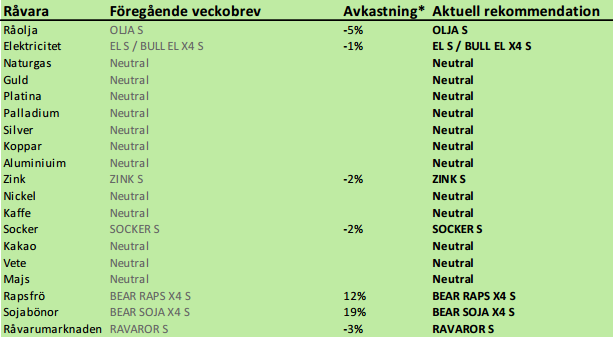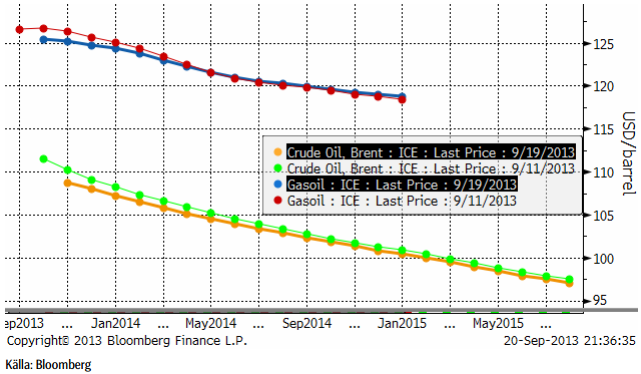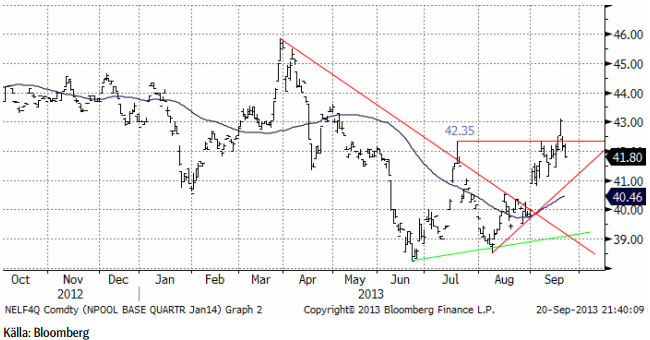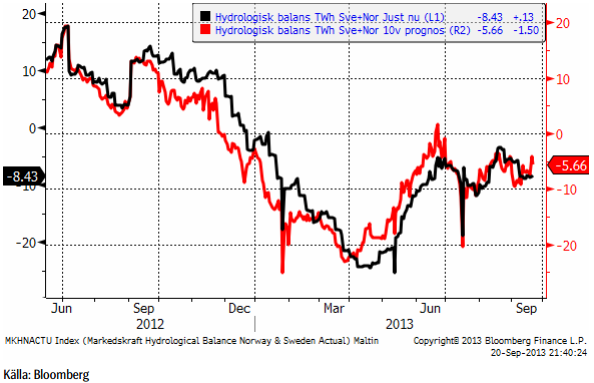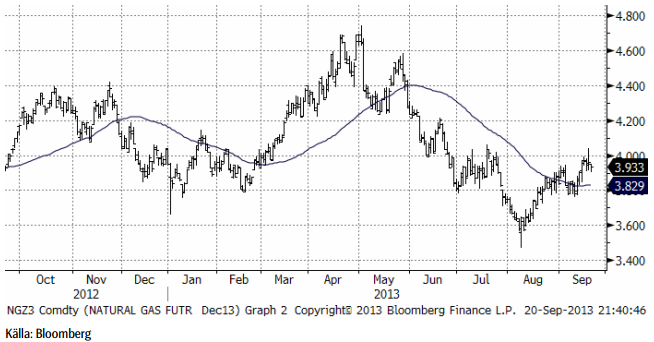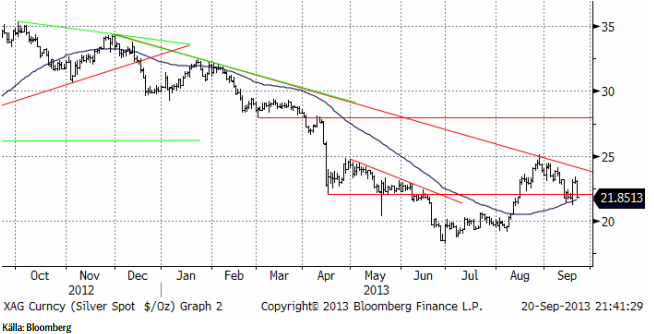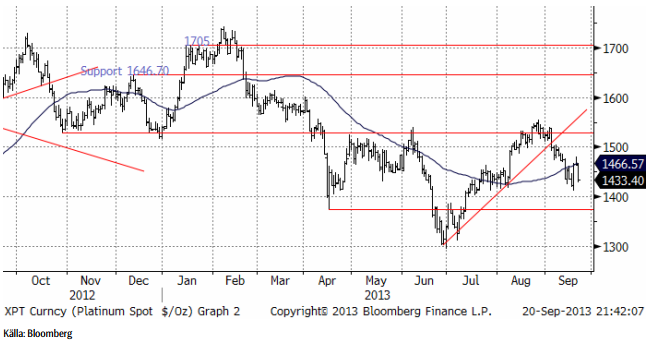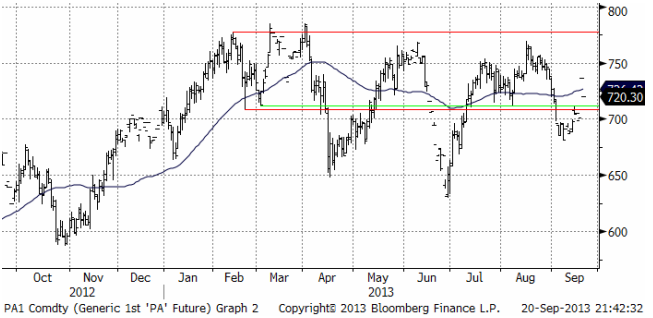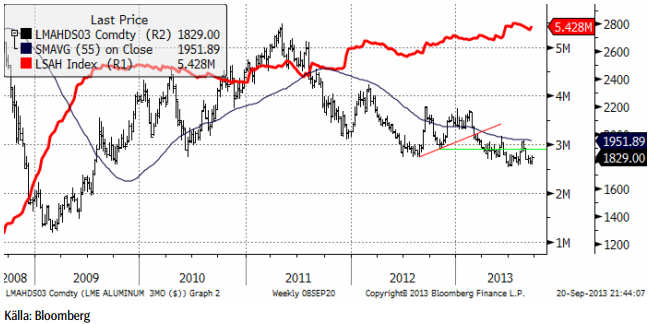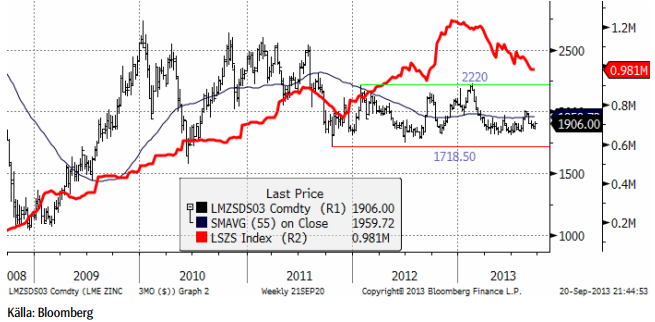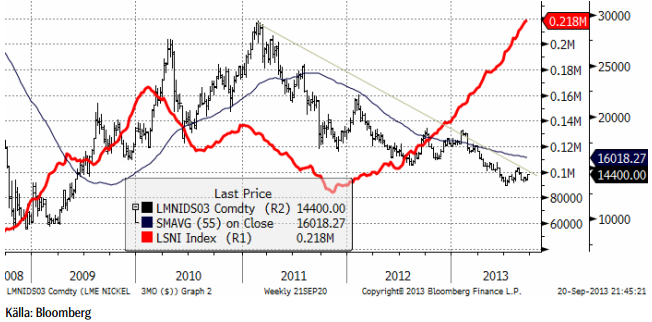Analys
SEB – Råvarukommentarer, 23 september 2013
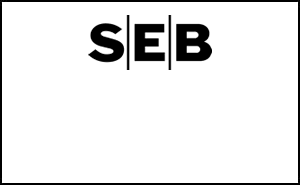
Rekommendationer
*) Avkastningen anges för 1:1 certifikaten där både BULL och 1:1 certifikat är angivna.
Inledning
Prisrörelserna förra veckan påverkades mycket av den amerikanska centralbanken. Först kom beskedet att det inte blir någon minskning i centralbankens (FED:s) köp av amerikanska obligationer, förrän tidigast år 2015. Anledningen är att man inte sett tillräcklig effekt på ekonomin än av de köp (och utbetalningar av pengar) som skett. Man kan fråga sig var de läst att sedelpressen någonsin skapat sysselsättning. Beslutet fick alla råvarumarknader att hoppa upp. Råvarulandet Brasliens aktiebörs blev den bästa av nästan 100 aktiebörser i världen, den dagen. I fredags gjorde så en medlem i FED ett uttalande som antydde att det ändå kan bli fråga om minskning i centralbankens återköp. Analytiker tolkade detta som en del i FED:s kommunikationsstrategi. Marknaderna föll abrupt på detta sent på fredagen. Jag ser dock detta inte som en medveten kommunikationsstrategi utan som ett tecken på oenighet i FED om fortsatt pengaproduktion är rätt väg. Det viktiga är dock att de som tycker att sedelpressen ska stå på är i majoritet och att dissidenterna är få. Vid det senaste FED-beslutet var det endast en person som var emot en förlängning till 2015. Kanske har marknaden kommit fram till samma slutsats under helgen. I så fall skulle priserna kunna gå upp i veckan som kommer.
Inga tekniska stödnivåer bröts i under fredagens prisfall – utom för sojabönor – men ”it had it coming”. Vår position i BEAR SOJA X4 S ökade i pris med 19% i veckan. Vi är fortsatt negativa till sojabönor och raps, men neutrala till spannmål och vi har köp på socker, samt köp på el och zink. Generellt sett är det, som en kollega i branschen uttryckte det i fredags, ett gyllene läge för råvaror som placering.
I torsdags var vi på Copenhagen Grain Exchange, som besöktes av rekordmånga från branschen. När man talade med folk var den allmänna bedömningen att priset på spannmål kommer att hålla sig stabilt på den här nivån åtminstone fram till våren. Det är i sig ett observandum, att man tror att volatiliteten kommer att vara låg och att priserna kommer att vara låga. Det finns inget som tyder på det, men skulle det komma nyheter som indikerar högre priser, finns ingen psykologisk förberedelse på detta.
Råolja – Brent
Oljepriset fortsatte att rekylera nedåt och gick även igenom den psykologiskt viktiga 110-dollarsnivån. Vi tycker att detta gör olja än mer köpvärt. Det är rabatten på terminerna som gör att vi vill vara investerade i olja.
Terminskurvorna för Brent (den lägre) och gasolja (mer eller mindre detsamma som diesel) ligger något lägre jämfört med förra veckan. Men notera att medan terminskurvan för brent fallit för alla löptider, har kurvan för gasolja faktiskt vridit sig, så att de längre terminskontrakten ligger högre än förra veckan. Det är också väsentligt lägre grad av backwardation i gasoljekurvan än i oljekurvan. Man får bättre betalt för att vara investerad i olja än i gasolja.
Nedan ser vi hur 100 dollar i början av januari 2011 utvecklat sig om man investerat i fysisk råolja (svart linje) eller via terminer (grön linje). På grund av rabatten på terminerna, har mer än hälften av de ca 35% avkastning under dessa två år kommit från dem – och inte från prisförändring på fysisk råolja.
För råvaruinvesterare är den här rabatten nu väldigt attraktiv. Man kan tjäna ca 7 – 10% extra på att äga råoljeterminer.
När nu priset fallit tillbaka och rabatten på terminer är så attraktiv, tycker vi att det är ett bra tillfälle att komma in i den lönsamma oljemarknaden och rekommenderar köp av OLJA S. Det är framförallt rabatten på terminerna vi vill komma åt och därför föredrar vi OLJA S framför t ex BULL OLJA X4 S.
Elektricitet
Elpriset gick i veckan över motståndet på 42.35 och vi har nu en teknisk köpsignal på el. Vi skulle dock inte bli förvånade om det kom en rekyl nedåt, efter den snabba prisuppgång som varit. En sådan rekyl nedåt ser vi som ett utmärkt köptillfälle.
Hydrologisk balans visar inge större förändringar i veckan. 10-veckors-prognosen visar på ett marginellt mindre underskott än förra veckan.
Vi rekommenderar köp av el, t ex EL S eller BULL EL X4 S.
Naturgas
Naturgaspriset studsade var uppe vid 4 dollar, en nivå som tidigare varit ett motstånd.
Vi har neutral rekommendation.
Guld & Silver
Guldpriset fann stöd på 1300 dollar och rusade uppåt på FED-beskedet om fortsatt penningpolitisk stimulans åtminstone till år 2015. Detta vände till panikförsäljning i fredags när marknaden tolkade uttalandet från St. Louis-FED:s chef som att det nog ändå kunde bli frågan om en minskning av obligationsköpen innan 2015. Den tekniska bilden indikerar att lägre pris är att vänta, men vi har ingen säljsignal än, bara en bruten uppgång.
Nedan ser vi kursdiagrammet för silver i dollar per troy ounce. Tekniskt ser marknaden faktiskt lite mer positiv ut än guld. Den fallande trenden är dock inte bruten och vi skulle inte vilja köpa så länge detta inte har skett.
Vi fortsätter att vara neutrala guld och silver och skulle inte vilja köpa någon av dem idag.
Platina & Palladium
Prisuppgången i platina hindrades vid 55-dagars glidande medelvärde. Tekniskt ser platina svagare ut än både silver och guld. Det är många som hoppas på att platina och palladium ska gå bättre än guld och silver, därför att de också har ett industriellt invändningsområde i katalysatorer. Det innebär att det finns mycket förhoppningar investerat redan i metallerna och egentligen, en ganska stor nedsida.
Nedan ser vi frontmånadskontraktet på palladium. Palladium är en ganska illikvid metall och vi ser att priset steg kraftigt i veckan och sedan föll tillbaka.
Palladiumpriset är tillbaka i den triangelformation vi talat om tidigare.
Vi är för närvarande neutrala platina och palladium, men om palladium skulle falla bara något lite ytterligare, skulle vi vilja haka på och ta en kort position via BEAR PALLAD X4 S. Vi skulle absolut inte vilja köpa någon av dem.
Koppar
Koppar var den basmetall som gick bäst i veckan med en uppgång på 2.5%, trots den generella svagheten på fredagen. Tekniskt bröts den kortsiktiga nedåttrenden i torsdags. SEB:s tekniska analytiker gjorde följande bedömning på fredagen: “Rechecking $+7,400 before down… There is some near-term momentum in the ongoing move higher, as it was able to gap through short-term resistance at ≈7,200 (now likely support). This behavior puts the Aug high of 7,420 in focus, but extension beyond this level should be restricted to the 233day moving average band (7,445\7,575)”.
Den fysiska marknaden rapporteras vara i någorlunda balans. Arbitraget mellan SHFE och LME fanns förra veckan (Shanghai 200 dollar högre). Lagren på LME har fallit ytterligare 2.2% i veckan.
Det ser positivt ut, men uppsidan är begränsad, enligt den tekniska analysen. Vi fortsätter därför att ha en neutral position.
Aluminium
Aluminiumprisets relativa svaghet var tydlig i veckan. Vi rekommenderar att man försöker köpa BEAR ALU X4 S på rekyler (uppåt).
Den oberoende analysfirman Wood Mackenzie publicerade en rapport i veckan som gick, som utmålade en mörk framtid för aluminiummarknaden de kommande åren. De förutspår ett överskott nästa år på 1.1 mt. Det är en rejäl ökning av överproduktionen om man jämför med årets 0.5 mt. Kina behöver stänga produktion på 1.6 mt för att regionen ska komma i balans, enligt rapporten. Det råder samstämmighet bland bedömare att marknaden behöver stora produktionsneddragningar. Den här rapporten pekar på att detta kan ta längre tid än de flesta hoppats.
Vi har neutral rekommendation, men tycker man ska försöka komma in i BEAR ALU X4 S på rekyler uppåt.
Zink
Som vi har noterat tidigare, håller zink-balansen (utbud/efterfrågan) på att förbättras. ILZG rapporterade siffrorna för juli och de visade ett litet överskott. Produktionen av raffinerad zink var 1.109 mt i juli och efterfrågan var 1.095. Detta tog bort optimismen och gav baissarna ammunition. Men faktum är att trenden går mot ett underskott. Det tar naturligtvis tid att beta av de uppkomna lagren, men det ligger i priserna. De flesta som följer marknaden är överens om att gruvkapacitet kommer att stängas nästa år, och att ny kapacitet inte kommer att kompensera detta. Det finns en stor möjlighet till stora underskott framöver. Detta kommer att ge marknaden stöd enligt vårt sätt att se. Samtidigt verkar ekonomierna i Kina, USA och Europa ta fart och den effekten på underskottet måste också beaktas.
Zink blev en besvikelse den här veckan efter den oväntade svagheten i fredags och stängde ner 0.5% på veckan.
Vi fortsätter med en försiktig köprekommendation, av ZINK S.
Nickel
Nickel är traditionellt den mest volatila av metallerna som handlas på LME och den levde upp till sitt rykte den här veckan. FEDbeskedet fick priset att stiga från 13900 dollar till 14400. Detta vändes sedan i dramatiskt prisfall på fredagskvällen och veckan stängde bara precis över 14000 dollar. De stora och stigande lager hänger hotfullt över marknaden, men vi märker av mer intressen att köpa metallen från industrin. Med tanke på vad den tekniska analysen säger, tror vi det finns möjligheter för priset att nå 15000 dollar inom överskådlig tid. Nyhetsflödet kring Indonesiens export av järnmalm med nickelinnehåll för tillverkning av Nickel Pig Iron i Kina kommer att spela en central roll och vara en källa till volatilitet i marknaden.
Kaffe
Den fallande trenden i kaffepriset tog ett nytt trappsteg ner i veckan som gick. Den här nedgången är den längsta i tid sedan 1993.
Regn i Brasilien har fått kaffeträden att sätta blomknoppar för en andra blomning. Dessa blommor kommer sedan att bli bönor. Den kommande skörden är den växelvis större. Den skörd som just bärgats var ett mellanår. Arabica är en varannanårsgröda.
Brasilianska bönor av ”good cup” kvalitet (även kallad ”Swedish quality”, faktiskt) handlades till 18 till 21 cents rabatt till noteringen på ICE i New York. ”Fine cup” kvalitet handlas till en rabatt på 13 cent enligt företaget Flavour Coffee i Rio de Janeiro.
Flavour Coffee rapporterade också att Conillons, som den brasilianska robustan kallas, handlas till 8 cents premium över LIFFE:s terminspris i London, en uppgång från förra veckans premium på 5 cent. Det fanns även vissa kvaliteter av robusta som var dyrare än arabica. Robusta odlas mest i Afrika och i Asien, där Vietnam har blivit den största producenten. Robusta används mest i snabbkaffe.
Brasilien kommer att bärga en rekordskörd, av allt att döma och globala lager ökade med över 7% i augusti enligt tradinghuset FC Stone.
Vi behåller tills vidare neutral rekommendation, tills vi ser tecken på ett trendbrott.
Fler analyser på jordbruksråvaror från SEB.
[box]SEB Veckobrev Veckans råvarukommentar är producerat av SEB Merchant Banking och publiceras i samarbete och med tillstånd på Råvarumarknaden.se[/box]
Disclaimer
The information in this document has been compiled by SEB Merchant Banking, a division within Skandinaviska Enskilda Banken AB (publ) (“SEB”).
Opinions contained in this report represent the bank’s present opinion only and are subject to change without notice. All information contained in this report has been compiled in good faith from sources believed to be reliable. However, no representation or warranty, expressed or implied, is made with respect to the completeness or accuracy of its contents and the information is not to be relied upon as authoritative. Anyone considering taking actions based upon the content of this document is urged to base his or her investment decisions upon such investigations as he or she deems necessary. This document is being provided as information only, and no specific actions are being solicited as a result of it; to the extent permitted by law, no liability whatsoever is accepted for any direct or consequential loss arising from use of this document or its contents.
About SEB
SEB is a public company incorporated in Stockholm, Sweden, with limited liability. It is a participant at major Nordic and other European Regulated Markets and Multilateral Trading Facilities (as well as some non-European equivalent markets) for trading in financial instruments, such as markets operated by NASDAQ OMX, NYSE Euronext, London Stock Exchange, Deutsche Börse, Swiss Exchanges, Turquoise and Chi-X. SEB is authorized and regulated by Finansinspektionen in Sweden; it is authorized and subject to limited regulation by the Financial Services Authority for the conduct of designated investment business in the UK, and is subject to the provisions of relevant regulators in all other jurisdictions where SEB conducts operations. SEB Merchant Banking. All rights reserved.
Analys
Volatile but going nowhere. Brent crude circles USD 66 as market weighs surplus vs risk

Brent crude is essentially flat on the week, but after a volatile ride. Prices started Monday near USD 65.5/bl, climbed steadily to a mid-week high of USD 67.8/bl on Wednesday evening, before falling sharply – losing about USD 2/bl during Thursday’s session.

Brent is currently trading around USD 65.8/bl, right back where it began. The volatility reflects the market’s ongoing struggle to balance growing surplus risks against persistent geopolitical uncertainty and resilient refined product margins. Thursday’s slide snapped a three-day rally and came largely in response to a string of bearish signals, most notably from the IEA’s updated short-term outlook.
The IEA now projects record global oversupply in 2026, reinforcing concerns flagged earlier by the U.S. EIA, which already sees inventories building this quarter. The forecast comes just days after OPEC+ confirmed it will continue returning idle barrels to the market in October – albeit at a slower pace of +137,000 bl/d. While modest, the move underscores a steady push to reclaim market share and adds to supply-side pressure into year-end.
Thursday’s price drop also followed geopolitical incidences: Israeli airstrikes reportedly targeted Hamas leadership in Doha, while Russian drones crossed into Polish airspace – events that initially sent crude higher as traders covered short positions.
Yet, sentiment remains broadly cautious. Strong refining margins and low inventories at key pricing hubs like Europe continue to support the downside. Chinese stockpiling of discounted Russian barrels and tightness in refined product markets – especially diesel – are also lending support.
On the demand side, the IEA revised up its 2025 global demand growth forecast by 60,000 bl/d to 740,000 bl/d YoY, while leaving 2026 unchanged at 698,000 bl/d. Interestingly, the agency also signaled that its next long-term report could show global oil demand rising through 2050.
Meanwhile, OPEC offered a contrasting view in its latest Monthly Oil Market Report, maintaining expectations for a supply deficit both this year and next, even as its members raise output. The group kept its demand growth estimates for 2025 and 2026 unchanged at 1.29 million bl/d and 1.38 million bl/d, respectively.
We continue to watch whether the bearish supply outlook will outweigh geopolitical risk, and if Brent can continue to find support above USD 65/bl – a level increasingly seen as a soft floor for OPEC+ policy.
Analys
Waiting for the surplus while we worry about Israel and Qatar

Brent crude makes some gains as Israel’s attack on Hamas in Qatar rattles markets. Brent crude spiked to a high of USD 67.38/b yesterday as Israel made a strike on Hamas in Qatar. But it wasn’t able to hold on to that level and only closed up 0.6% in the end at USD 66.39/b. This morning it is starting on the up with a gain of 0.9% at USD 67/b. Still rattled by Israel’s attack on Hamas in Qatar yesterday. Brent is getting some help on the margin this morning with Asian equities higher and copper gaining half a percent. But the dark cloud of surplus ahead is nonetheless hanging over the market with Brent trading two dollar lower than last Tuesday.

Geopolitical risk premiums in oil rarely lasts long unless actual supply disruption kicks in. While Israel’s attack on Hamas in Qatar is shocking, the geopolitical risk lifting crude oil yesterday and this morning is unlikely to last very long as such geopolitical risk premiums usually do not last long unless real disruption kicks in.
US API data yesterday indicated a US crude and product stock build last week of 3.1 mb. The US API last evening released partial US oil inventory data indicating that US crude stocks rose 1.3 mb and middle distillates rose 1.5 mb while gasoline rose 0.3 mb. In total a bit more than 3 mb increase. US crude and product stocks usually rise around 1 mb per week this time of year. So US commercial crude and product stock rose 2 mb over the past week adjusted for the seasonal norm. Official and complete data are due today at 16:30.
A 2 mb/week seasonally adj. US stock build implies a 1 – 1.4 mb/d global surplus if it is persistent. Assume that if the global oil market is running a surplus then some 20% to 30% of that surplus ends up in US commercial inventories. A 2 mb seasonally adjusted inventory build equals 286 kb/d. Divide by 0.2 to 0.3 and we get an implied global surplus of 950 kb/d to 1430 kb/d. A 2 mb/week seasonally adjusted build in US oil inventories is close to noise unless it is a persistent pattern every week.
US IEA STEO oil report: Robust surplus ahead and Brent averaging USD 51/b in 2026. The US EIA yesterday released its monthly STEO oil report. It projected a large and persistent surplus ahead. It estimates a global surplus of 2.2 m/d from September to December this year. A 2.4 mb/d surplus in Q1-26 and an average surplus for 2026 of 1.6 mb/d resulting in an average Brent crude oil price of USD 51/b next year. And that includes an assumption where OPEC crude oil production only averages 27.8 mb/d in 2026 versus 27.0 mb/d in 2024 and 28.6 mb/d in August.
Brent will feel the bear-pressure once US/OECD stocks starts visible build. In the meanwhile the oil market sits waiting for this projected surplus to materialize in US and OECD inventories. Once they visibly starts to build on a consistent basis, then Brent crude will likely quickly lose altitude. And unless some unforeseen supply disruption kicks in, it is bound to happen.
US IEA STEO September report. In total not much different than it was in January
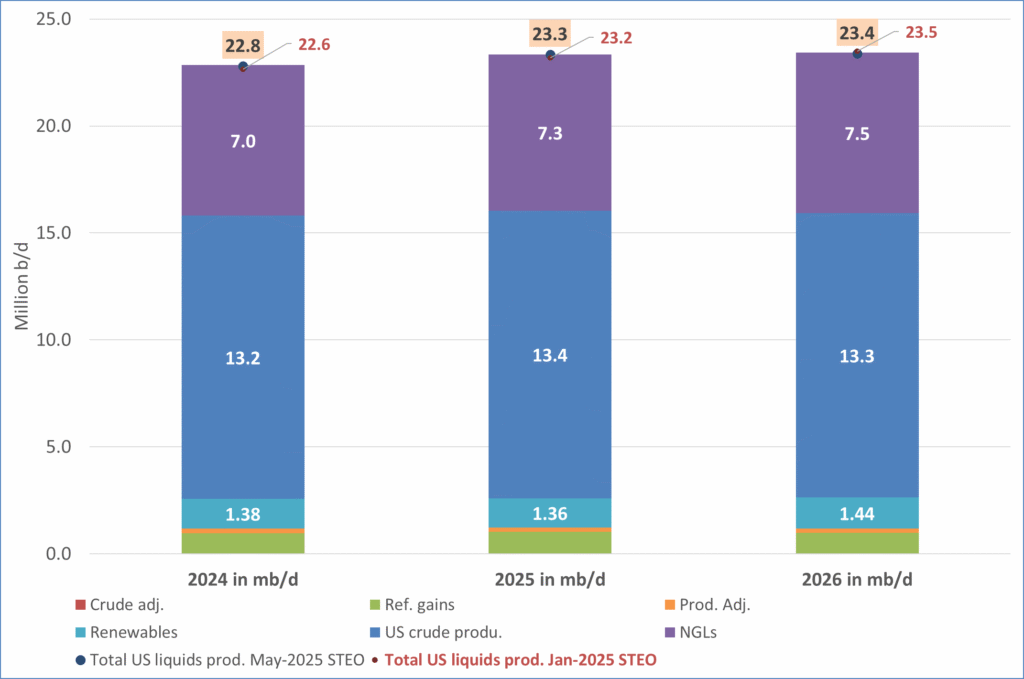
US IEA STEO September report. US crude oil production contracting in 2026, but NGLs still growing. Close to zero net liquids growth in total.
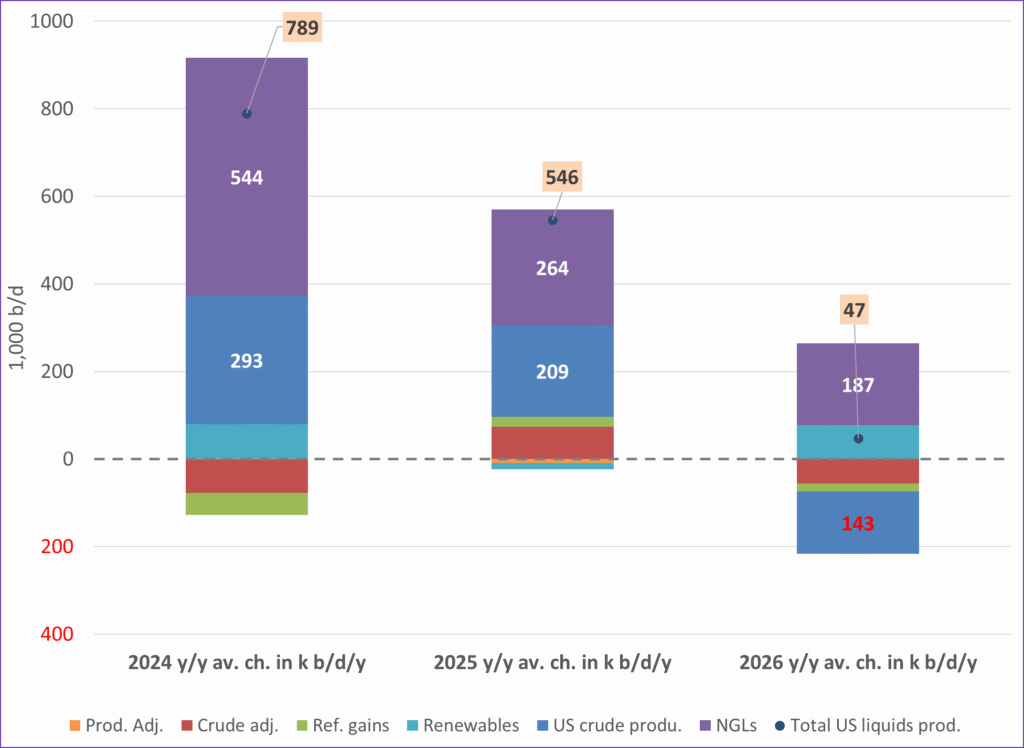
Analys
Brent crude sticks around $66 as OPEC+ begins the ’slow return’

Brent crude touched a low of USD 65.07 per barrel on Friday evening before rebounding sharply by USD 2 to USD 67.04 by mid-day Monday. The rally came despite confirmation from OPEC+ of a measured production increase starting next month. Prices have since eased slightly, down USD 0.6 to around USD 66.50 this morning, as the market evaluates the group’s policy, evolving demand signals, and rising geopolitical tension.

On Sunday, OPEC+ approved a 137,000 barrels-per-day increase in collective output beginning in October – a cautious first step in unwinding the final tranche of 1.66 million barrels per day in voluntary cuts, originally set to remain off the market through end-2026. Further adjustments will depend on ”evolving market conditions.” While the pace is modest – especially relative to prior monthly hikes – the signal is clear: OPEC+ is methodically re-entering the market with a strategic intent to reclaim lost market share, rather than defend high prices.
This shift in tone comes as Saudi Aramco also trimmed its official selling prices for Asian buyers, further reinforcing the group’s tilt toward a volume-over-price strategy. We see this as a clear message: OPEC+ intends to expand market share through steady production increases, and a lower price point – potentially below USD 65/b – may be necessary to stimulate demand and crowd out higher-cost competitors, particularly U.S. shale, where average break-evens remain around WTI USD 50/b.
Despite the policy shift, oil prices have held firm. Brent is still hovering near USD 66.50/b, supported by low U.S. and OECD inventories, where crude and product stocks remain well below seasonal norms, keeping front-month backwardation intact. Also, the low inventory levels at key pricing hubs in Europe and continued stockpiling by Chinese refiners are also lending resilience to prices. Tightness in refined product markets, especially diesel, has further underpinned this.
Geopolitical developments are also injecting a slight risk premium. Over the weekend, Russia launched its most intense air assault on Kyiv since the war began, damaging central government infrastructure. This escalation comes as the EU weighs fresh sanctions on Russian oil trade and financial institutions. Several European leaders are expected in Washington this week to coordinate on Ukraine strategy – and the prospect of tighter restrictions on Russian crude could re-emerge as a price stabilizer.
In Asia, China’s crude oil imports rose to 49.5 million tons in August, up 0.8% YoY. The rise coincides with increased Chinese interest in Russian Urals, offered at a discount during falling Indian demand. Chinese refiners appear to be capitalizing on this arbitrage while avoiding direct exposure to U.S. trade penalties.
Going forward, our attention turns to the data calendar. The EIA’s STEO is due today (Tuesday), followed by the IEA and OPEC monthly oil market reports on Thursday. With a pending supply surplus projected during the fourth quarter and into 2026, markets will dissect these updates for any changes in demand assumptions and non-OPEC supply growth. Stay tuned!
-

 Nyheter4 veckor sedan
Nyheter4 veckor sedanMeta bygger ett AI-datacenter på 5 GW och 2,25 GW gaskraftverk
-
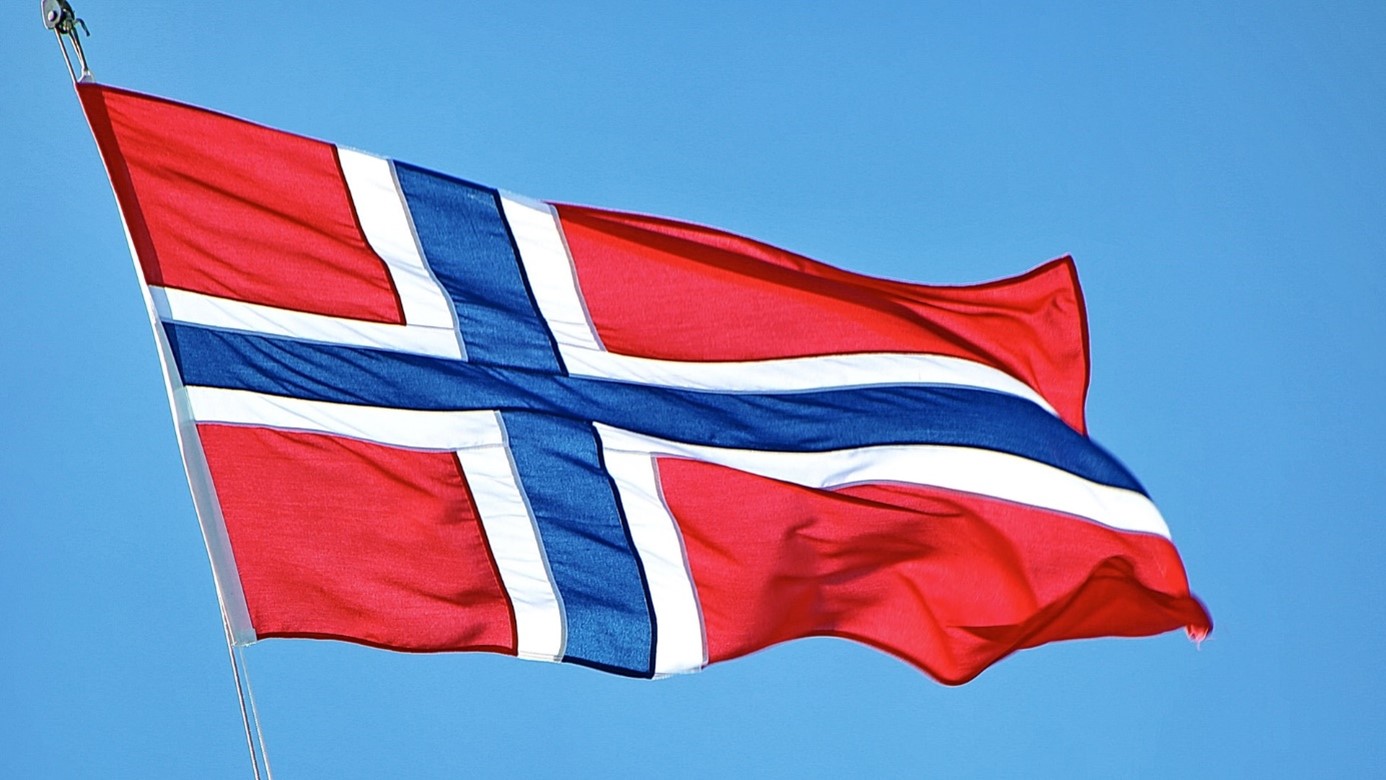
 Nyheter4 veckor sedan
Nyheter4 veckor sedanAker BP gör ett av Norges största oljefynd på ett decennium, stärker resurserna i Yggdrasilområdet
-

 Analys4 veckor sedan
Analys4 veckor sedanBrent sideways on sanctions and peace talks
-

 Nyheter4 veckor sedan
Nyheter4 veckor sedanEtt samtal om koppar, kaffe och spannmål
-

 Nyheter4 veckor sedan
Nyheter4 veckor sedanSommarens torka kan ge högre elpriser i höst
-

 Analys4 veckor sedan
Analys4 veckor sedanBrent edges higher as India–Russia oil trade draws U.S. ire and Powell takes the stage at Jackson Hole
-
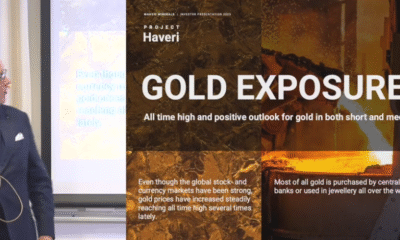
 Nyheter3 veckor sedan
Nyheter3 veckor sedanMahvie Minerals är verksamt i guldrikt område i Finland
-

 Analys3 veckor sedan
Analys3 veckor sedanIncreasing risk that OPEC+ will unwind the last 1.65 mb/d of cuts when they meet on 7 September


